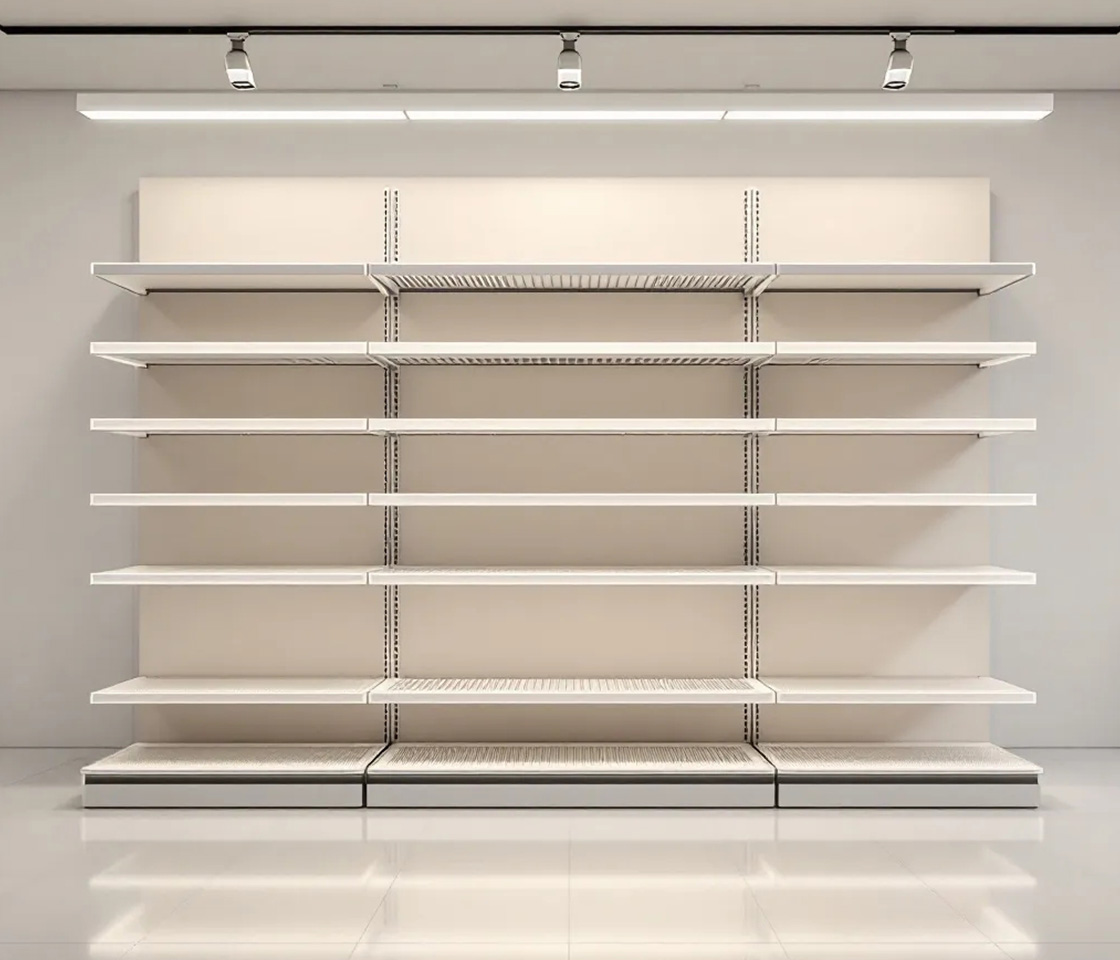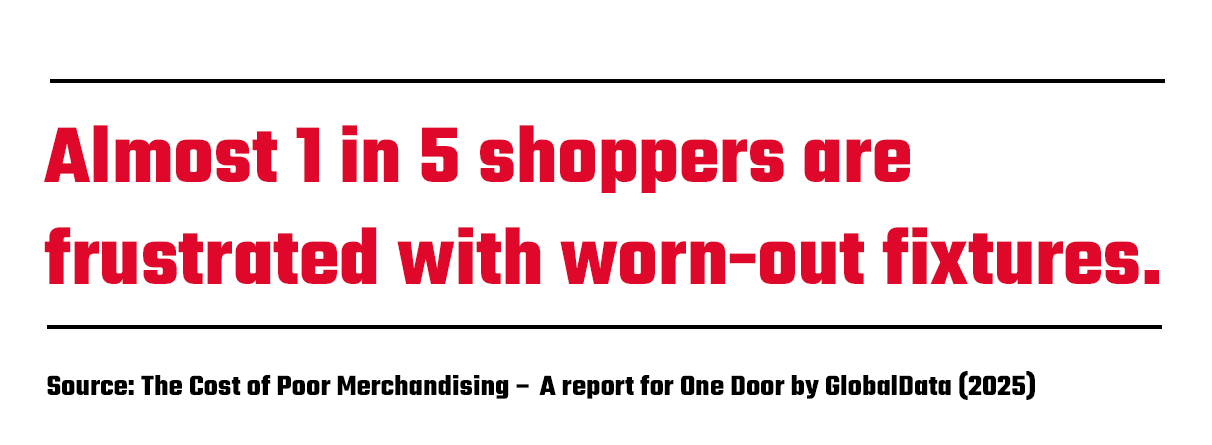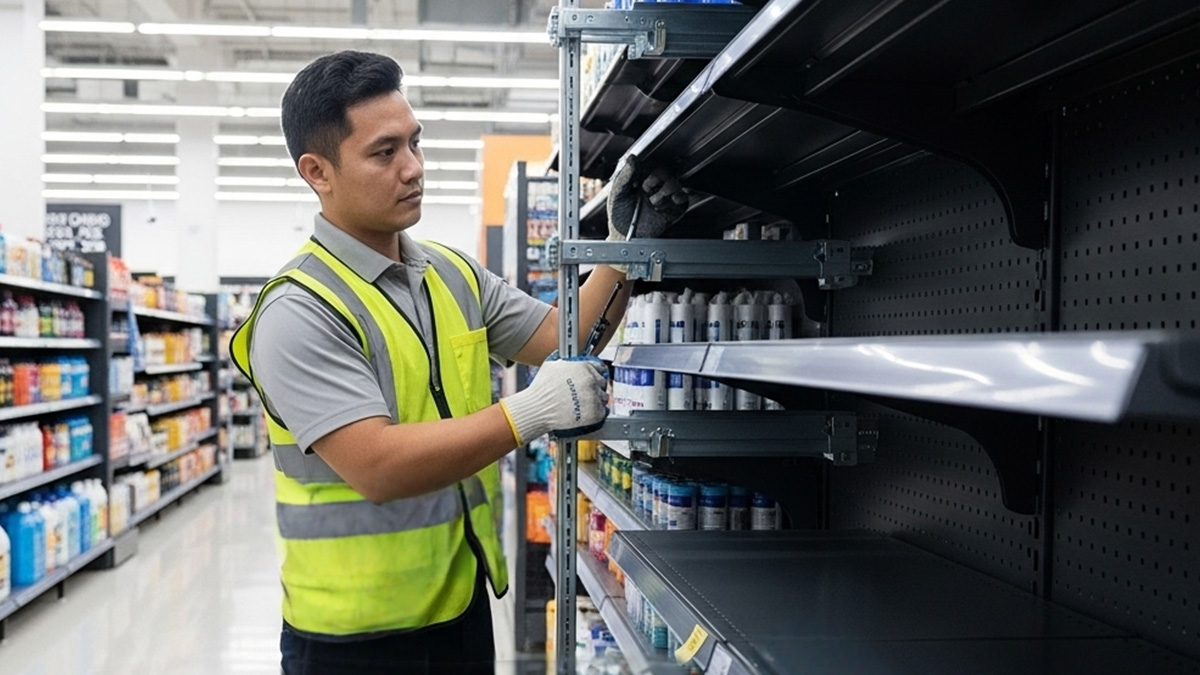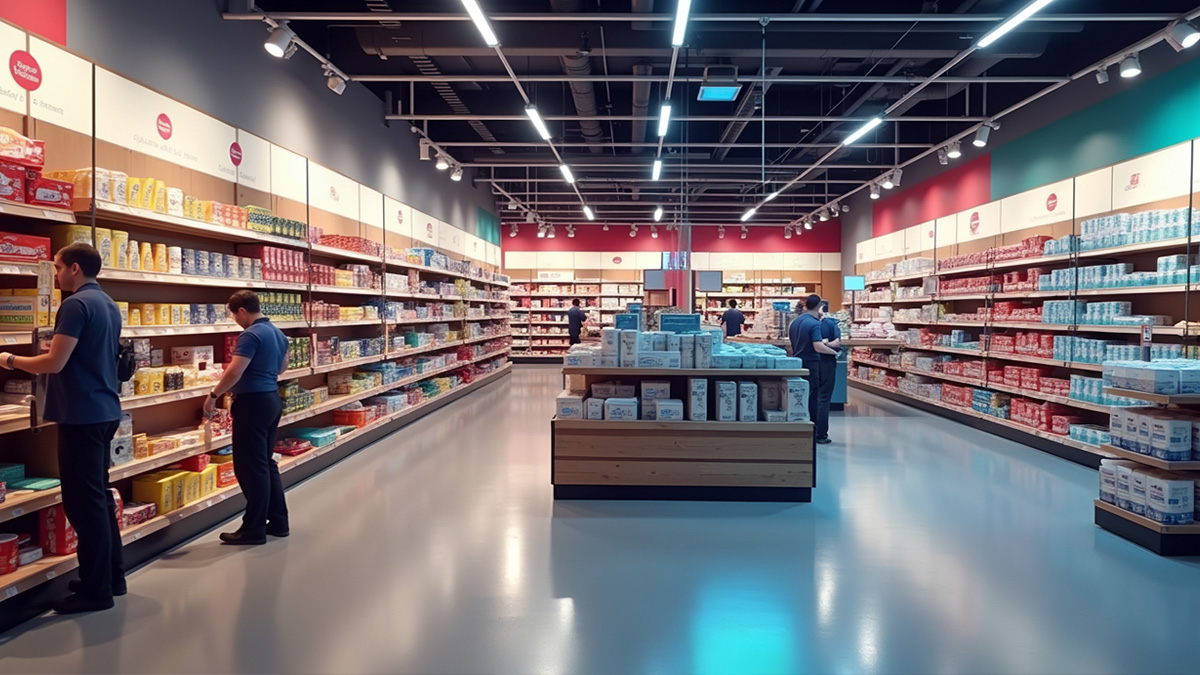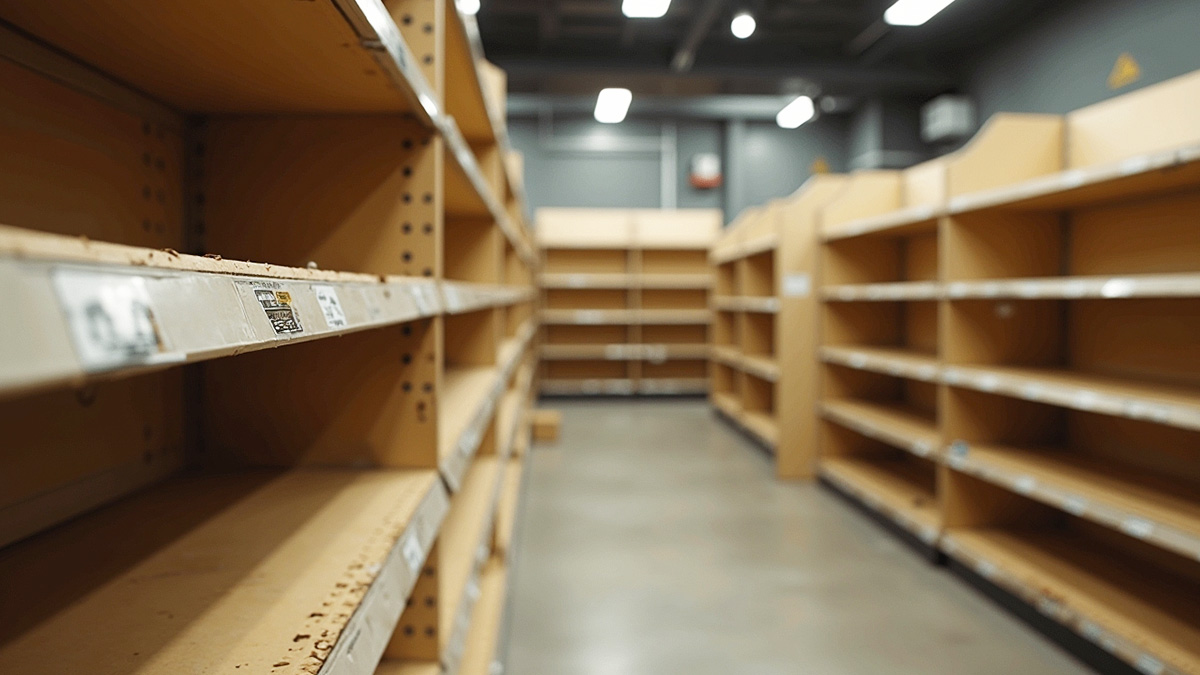Outdated or broken gondola shelving systems represent a critical business risk that directly impacts sales performance, customer experience, brand perception, and operational efficiency.
Walk through an older retail store and you’ll spot the telltale signs: unlevel and sagging shelves, dents, dings, scratches, and rust. These aren’t just aesthetic issues; they’re safety and operational concerns. These common gondola system issues affect structural stability, compromise safety, and make every planogram reset feel like solving a puzzle with missing pieces.
Furthermore, the impact goes beyond maintenance concerns. Outdated, broken, or poorly maintained gondola shelving systems have a significant impact on your brand, the shopping experience, and ultimately, your sales.
In this article, we’re going to break down the hidden costs, show you how to identify when it’s time for replacement, and help you build the business case for fixture upgrades.
The Hidden Costs of Aging Gondola Shelving Systems
Retailers selling high-volume, low-margin goods need to move as quickly and efficiently as possible. If your fixtures can’t keep up, every aspect of your operation suffers.
Surprisingly, the largest hidden cost isn’t the cost of maintenance, but rather the cost of a lack of flexibility.
Here are five ways gondola shelving systems impact operations:
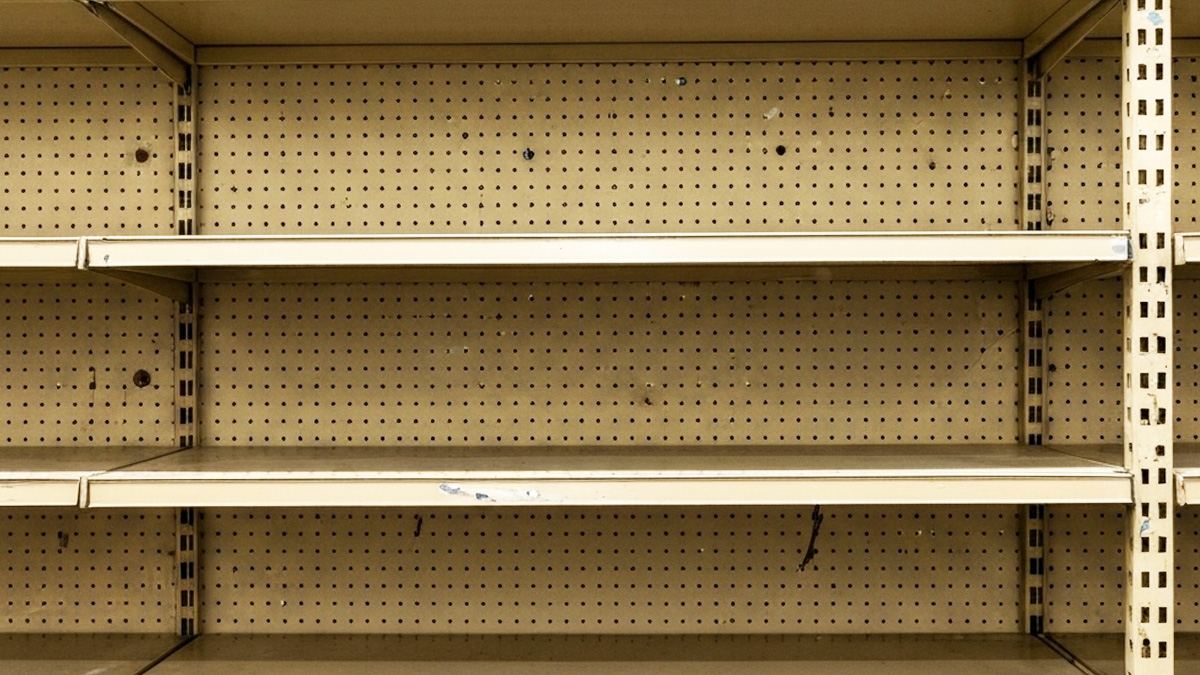
#1) Labour Inefficiency: When Simple Tasks Become Complex
- Every minute spent wrestling with non-modular shelving during a planogram reset is time that could be spent elsewhere. This often turns straightforward resets into time-consuming jobs.
- Flexible, modular gondola systems can dramatically cut the time needed for resets compared to older, less adaptable fixtures that require custom adjustments and creative workarounds.
- When retailers execute frequent planogram changes throughout the year, the lack of efficiency compounds quickly.
- Misaligned uprights, incompatible brackets, and non-standard measurements force staff to improvise solutions instead of following standard procedures.
Key Takeaway: Time is money, and outdated fixtures are stealing both from your operation.
#2) Maintenance Costs Multiply Over Time
- Aging gondola systems require increasingly frequent maintenance.
- Components wear out, connection points loosen, and standardized replacement parts become harder to source (especially for discontinued product lines).
- Unlike newer modular systems designed for easy component replacement, older fixtures often require custom repairs or complete section replacements.
- What starts as minor touch-ups turns into major repairs, with costs compounding as different issues arise across a run.
Key Takeaway: Modern, durable shelving systems significantly reduce long-term maintenance requirements while improving reliability.
#3) Lost Merchandising Opportunities
Outdated fixtures restrict your ability to:
- Quickly adapt layouts for seasonal promotions to make the most of short selling windows.
- Test new merchandising strategies without committing to custom modifications.
- Respond rapidly to changing product lines or sudden trend shifts that require different display configurations.
- Maximize space utilization through modular reconfiguration.
Key Takeaway: When you can’t pivot quickly during peak seasons or promotional periods, you’re missing out on sales opportunities.
#4) Broken Fixtures Damage Brand Perception
- Customers form impressions within seconds of entering a store.
- Store appearance directly influences how customers perceive product quality and brand trustworthiness.
- Outdated and broken retail shelving systems signal underinvesting or a lack of maintenance that can undermine confidence in your brand – regardless of actual product quality.
- When fixtures look tired, customers may question whether your products and service will meet their expectations, potentially choosing competitors with more polished presentations.
Key Takeaway: Your fixtures are part of your brand story. Make sure they’re telling the right one.
#5) Customers Experience Friction Points
Broken or poorly functioning fixtures create friction in the shopping experience:
- Products that fall off unstable shelves frustrate customers and create safety concerns that staff must constantly address.
- Misaligned gondolas create awkward traffic flow, making it harder for customers to navigate, potentially causing congestion during busy periods.
- Inconsistent shelf heights make product comparison difficult, forcing customers to work harder to evaluate their options.
- Unstable fixtures feel unsafe, especially for families with children, creating anxiety that detracts from the shopping experience.
Key Takeaway: These friction points increase the likelihood that customers will cut their shopping trip short or choose competitors with more polished presentations.
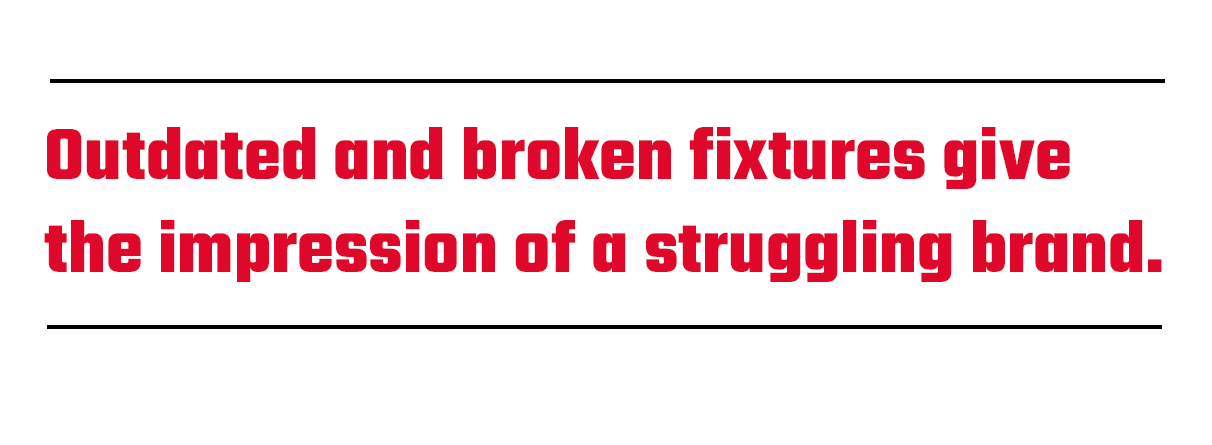 When to Repair vs. Replace Gondola Shelving
When to Repair vs. Replace Gondola Shelving
In most retail environments, gondola shelving is expected to last years (often 10+ if properly maintained). But knowing when to repair versus replace depends on safety, functionality, and appearance.
Here’s a framework retailers can use:
Acceptable Wear vs. Red Flags
Acceptable:
- Light scratches, scuffs, or chips in paint/powder coat.
- Minor cosmetic dents that don’t affect load-bearing capacity.
- Small areas of finish wear that can be touched up.
Unacceptable (Replace/Repair Immediately):
- Bent or cracked brackets/forks (compromise shelf safety).
- Loose uprights or broken base shoes (affect stability).
- Sagging shelves or metal fatigue (structural failure risk).
- Rust that affects strength (especially around welds or joints).
- Misaligned uprights (can’t keep shelves level/secure).
Replace Parts vs. Replace A Full Run vs. Replace The Entire Store
Replace parts only when:
- Individual shelves, brackets, or uprights show damage.
- Cosmetic issues are isolated and repairable with paint kits or replacement parts.
Replace a full run when:
- Multiple connected bays show structural damage.
- The run no longer aligns properly (leaning, warped uprights, repeated bracket failures).
Replace all shelving in the store when:
- Age or style makes the system incompatible with new parts (old lines may be discontinued).
- Widespread corrosion or failure appears across multiple runs.
- A major remodel or rebrand requires updated finishes, heights, or configurations.
The Bottom Line
Whether you’re dealing with minor cosmetic issues or major structural problems, your fixtures are either working for you or against you.
The five hidden costs we’ve covered (labour inefficiency, mounting maintenance, lost merchandising opportunities, damaged brand perception, and customer friction) all compound over time.
While it’s tempting to hold out on replacing aging gondola shelving systems, the truth is they’re steadily eroding your retail operation’s efficiency, customer experience, and sales.
For retailers competing for every customer and every dollar, the question isn’t whether you can afford to replace your fixtures; it’s whether you can afford not to.
Don’t let fixture inefficiencies hurt your retail operations. Get a quote for reliable gondola shelving systems that actually work for your business.
Want more retail design insights? Join 400+ retail professionals who read our email newsletter full of practical advice and design ideas. https://mailchi.mp/8a889d2ab116/v

